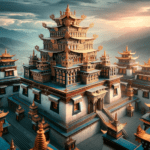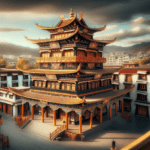Diure Temple: A Historical Sanctuary in Tibetan Buddhism
Overview of Diure Temple
Location and Etymology: Diure Temple, nestled in Xinba Township, Longzi County, Tibet, stands at an altitude of 3940 meters. The name ‘Diure’ translates to “the temple built next to the horse pen” in Tibetan, reflecting its unique origin. Founded in the 13th century by Cha Rosova, the temple boasts a history of over 700 years.
Architectural Evolution Across Centuries
Early, Middle, and Late Period Structures: Diure Temple’s architecture can be categorized into three distinct periods:
- Early Building: Originally located on the north bank of the Longzi River, these structures were unfortunately destroyed during the Mongolian Junggar invasion.
- Mid-Term Building: The first batch of buildings post-relocation, primarily Dukang and Gongkang, have now collapsed.
- Late Building: The current standing structure, known as Zubra Kang, represents the late period of the temple’s architectural development.
Religious Transformation and Community
Shift from Sakya to Gelug Sect: Initially a Sakya sect temple, Diure Temple transitioned to the Gelug sect in the 14th century. At its zenith, the temple was home to hundreds of monks, whereas it currently houses 16 monks, under the guidance of the master Luosang Yeshi.
The Present-Day Temple Structure
Zubulakang: The Heart of Diure Temple
- Location and Dimensions: Zubulakang, situated in the east of the temple complex, is a two-story structure. The ground floor includes the Dukang Hall and the Buddhist Hall.
- Construction Details: The building is constructed with stone walls, featuring round wooden lions on the south eaves and edge ma grass for the eaves. The north side is adorned with 12 wooden brackets projecting the corners of the eaves.
- Porch and Main Hall: The Dukang Hall has a porch covering about 45 square meters, leading to the main hall. The hall is square in plan, with dimensions of 18.4 meters by 17.4 meters. It consists of square columns arranged in a grid pattern, with a column spacing of 2 meters by 2.4 meters. The central four columns support the upper floor, creating a patio-style shed.
Other Key Structures:
- Buddhist Hall: Located behind the Dukang Hall, this area spans about 16 square meters.
- Dharma Protector Temple: Situated on the east side, it occupies approximately 20 square meters, dedicated to housing religious rituals and protector deities.
Murals and Artistic Heritage
The temple’s murals are well-preserved, offering a visual journey through Tibetan Buddhist art and history. These murals add to the cultural and spiritual significance of Diure Temple, making it a site of interest not only for religious purposes but also for art and history enthusiasts.
Diure Temple, with its rich history, architectural evolution, and religious transformations, stands as a significant monument in the landscape of Tibetan Buddhism. Its enduring structures, combined with the artistic wealth of its murals, make it a testament to the spiritual and cultural resilience of the region.
Diure Temple’s Dukang Hall Murals: A Tapestry of Tibetan Buddhist Art
① Murals in the Dukang Hall
South Wall:
- West Section: Features the incarnation of the Lord Vajrayana and the Mother of Vajrasana, depicted with eight statues, each surrounded by flame-shaped backlights and riding horses.
- East Section: This area showcases a goddess riding a mule, a six-armed god, and statues of Yamantaka and Yama Dharma Protector, arranged from east to west.
West Wall:
- Depictions from South to North: Includes paintings of the protector Chang Xing, Vairochana Buddha, an Indian great virtue, and the “Two Saints and Six Ornaments” (Atisha, Zhongdunba, and their disciples). A prominent portrait of Tsongkhapa and the lam lineage system is also featured here.
East Wall:
- Northern Section: Dedicated to the biography of Sakyamuni and images of the Sixteen Arhats.
- Middle Section: Displays the Eight Medicine Master Buddhas and their followers.
- Southern Section: Presents the three-faced, eight-armed Guanyin Bodhisattva, surrounded by maids and followers. The adjacent area showcases Vajradhara Buddha and Padmasambhava.
Among these, the “Biography of Sakyamuni” and the depiction of “Avalokitesvara with Three Faces and Eight Arms” are particularly exquisite. The former illustrates key moments in Buddha’s life, from descent from the heavenly palace to his Nirvana, concisely and vividly. The latter shows Guanyin Bodhisattva with a spiritual pagoda in the background, flanked by figures and the Bodhisattva of Joy amidst colourful clouds. The incense maids on either side of the main deity add to the mural’s elegance and grace.
② Murals in the Porch and Shed of the Main Hall
Porch Wall Paintings:
- North Wall: Adorned with images of the Four Heavenly Kings.
- South Wall: Features statues of the temple’s guardian deity Jirab, along with Lhamo and Garmaningda. These figures, once attendants of the temple’s seventh-generation living Buddha, are now revered as male and female Dharma protectors.
Bright Shed Murals: In the courtyard’s illuminated shed, the murals include depictions of six-armed gods, Vajradhara, Hayagriva, the three masters and disciples of Tsongkhapa, the first Dalai Lama Gendun Drupa, and Tsongkhapa’s disciple Kedrupje.
Conclusion
The murals in Diure Temple’s Dukang Hall are a splendid representation of Tibetan Buddhist art. They not only showcase the rich iconography and religious narratives of Tibetan Buddhism but also demonstrate the artistic mastery of mural painting from historical times. These murals serve as a vibrant visual chronicle, preserving the spiritual and cultural essence of the temple’s long-standing heritage.















